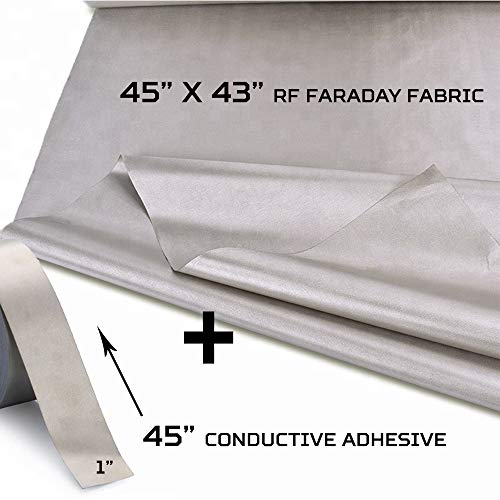We ♥︎ honesty! Beat EMF may earn a commission through links on this page at no additional cost to you.
Listening to the radio, texting, and watching TV….
All of these are possible thanks to radio waves.
But when you realize the effect radio waves have on your body, you might want to block them from flooding your home.
I want to talk a little more about that today and explain the whys and hows.
First, the radio wave has the longest wavelength and the lowest frequency in the electromagnetic spectrum.
We’re most familiar with them as being generated with the help of a transmitter, but they can also be produced by lightning – even stars.

ELIMINATE THE MYSTERY (& OVERWHELM) OF EMF PROTECTION
Get a self-paced, step-by-step path to less EMF in your life—without weighing you down with complicated terminology & information overload.
Radio waves are extremely useful in allowing the function of technology such as communication, wireless computer networks, radio navigation, and broadcasting.
But they do have their downsides, which we’ll discuss in just a minute.
Examples of Radio Waves
Radio waves can either be generated through natural sources or from artificial objects.
For instance, when certain astronomical phenomena or weather disturbances occur, these waves can be created.
While man-made sources like radar, satellites, broadcast radio towers, and cellphones can also produce these waves.
They have a number of subcategories – two of which are AM and FM radio. These kinds of radio waves are the most familiar as nearly everyone interacts with them while riding in a car.
Let’s take a look at AM radio waves first…
AM stands for amplitude moderation, which refers to the method of putting information on waves.
These radio waves have a frequency that ranges from 540 kHz to 1600 kHz and is typically used as a carrier of commercial radio signals.
On the other hand, FM radio uses a frequency range of 88 MHz to 108 MHz. Just like AM, FM radio waves are also used for commercial radio transmission.
FM is an abbreviation for frequency modulation and also functions as a carrier of information.
When FM carries information, the signal amplitude does not change, but its frequency can vary.
Meanwhile, when AM carries the information, it is the frequency that remains the same while its amplitude changes.
Video Credit: Best Of Science
Other types of radio waves include those used by submarines when underwater. These radio waves operate at extremely low frequencies.
Since they have long wavelengths, they can easily penetrate through saltwater.
And salt water acts as a conducting agent, easily absorbing the radio waves. Thus, the waves’ length is useful in reaching submarines.
Then there’s the radio frequencies that are generated from transmission lines with high-voltage AC power.
How to Detect Radio Waves at Home
Before learning how to detect radio waves, it’s first necessary to understand how the waves are transmitted.
For a radio wave to be generated, we need a transmitter and a receiver.
With the help of an antenna, the transmitter can transmit information in the form of energy into space.
The receiver will then pick up these radio signals at a certain frequency.
Now, how can you determine the presence of radio waves in your house?
The easiest and most obvious way to do so is to check for cell phone reception.
That’s because the only reason your cell phone can properly receive and send information is thanks to radio waves.
And so, if your phone can’t reach a signal, it means there’s something interfering and/or blocking nearby radio waves.
However, if you want more accurate readings, you can use an EMF reader.
These detectors are made to measure electromagnetic fields.
I personally use the Trifield TF2, which measures radio frequencies in addition to electric and magnetic fields.
Now let’s get to the nitty gritty…
What Blocks Radio Frequencies?
Have you ever experienced talking to someone on the phone, and then suddenly you lost reception when you entered a certain room or passed through a tunnel?
That happened because the radio waves – which make communication possible – are disrupted somehow.
Certain materials can block, reflect, and interfere with how radio waves reach the receiving antenna.
To determine what objects can block radio frequencies, an experiment was done (and published over at Scientific American) using a remote-control toy car and various materials like:
- wax paper
- plastic wrap
- rubber glove
- cotton
- aluminum foil

The idea was to wrap the remote control with the 5 materials to find out whether the car could still operate through the remote.
In the experiment, they covered the remote completely – using one material at a time – with no gaping holes or openings.
Then they tested the toy car with the remote first uncovered to ensure everything was in proper working order, then covered.
From this setup, they observed which materials still allowed the car to operate and which ones blocked the radio waves.
It was also noted whether the remote needed to be completely covered in order to successfully block the radio waves.
Here’s how it all played out:
Without any covering, the remote acted as a transmitter of radio waves, which were received by the car.
Whether or not a material can interfere with this process largely depends on a material’s composition and thickness.
For example, when the remote was fully enclosed in aluminum foil, the radio waves were completely blocked.
But with the rubber glove, cotton, wax paper, and plastic wrap, they were not.
Why did the aluminum foil work so well in blocking radio waves?
Because it’s a highly electrically conductive metal.
It can interfere with the transmission of radio waves because it’s highly absorbent.
Other metals that work just like aluminum are copper, silver, and nickel.
That’s why they’re used to produce RF shielding products like clothing, smart meter shields, and more.
Now let’s look at some more materials that don’t block radio waves.
What Materials Can Radio Waves Pass Through?
From the same experiment discussed above, we kinda get an idea what kinds of materials allow radio waves to simply pass through.
Objects like dry wood, plastic, glass, rubber, cotton, wax paper are generally non-conductors that don’t block radio waves.
In your home, for instance, radio waves can easily pass through walls, doors, windows, or even small spaces.
That’s why you can still receive phone calls while indoors, watch live television broadcasting, and listen to the radio.
It’s important to note that radio waves have the ability to penetrate through certain materials because of their frequencies.
For example, lower frequency radios like AM can pass through buildings and walls.
But for microwaves, which have a higher frequency than radio, they don’t typically pass through.
If it so happens that a wall is made from a conductive material or contains an electrically conductive sheet, the radio waves would be blocked.
This would be the case in those faraday rooms you may have seen on YouTube.
What Reflects Radio Waves?
Normally, radio waves follow a straight direction when traveling through space.
However, there are 2 instances when waves can be reflected:
The first situation is when radio waves are reflected by a smooth metal surface like a mirror.
The second one happens when gravity acts on the waves, pulling and turning them, especially when they’re passing large objects.
Think about the antennas of radio signals.
Instead of having the antenna perched on a tall, straight tower, there is a curved surface beneath it.
The structure is designed like this so that the radio waves can be reflected properly in the antenna.
The best kind of medium that can reflect radio waves are those made from conductive materials (usually metal but not always – remember, water is conductive too).
Now let’s look at the most common – and effective – ways to block radio waves.
5 Ways to Block Radio Waves in Your House
There are a number of ways to prevent radio waves from entering your living space.
But before you perform protective measures around your house, you need to recognize common sources of radiofrequency in your area.
Measuring the EMF level around your home is a good way to find penetration points and devices that can produce radio waves.
It’s important to note that for any protective installations to work, you don’t want to use devices that emit radio waves within the protected area.
Since we are a techy society, most people don’t shield their entire home but just one or two rooms, usually bedrooms.
Here are 5 steps you can take to keep radio waves from entering your home.
1. Apply RF blocking paint on your walls
Many buildings that are made from concrete can already block 90% of electromagnetic radiation.
However, in cases where radio waves are so strong that other materials can’t block them, the most recommended product to use is a carbon-based RF blocking paint.
It provides a protective coating that can be used on external and internal walls that radio waves can’t penetrate efficiently.
In fact, you get about a 90-95% reduction.
It can cancel out electric fields as well if you ground it.
Apart from walls, RF blocking paint also works well on ceilings and even floors if you wanted to paint the subfloor before installing hardwoods.
Even though this kind of paint is pricey, it’s durable and long-lasting. You paint once, and you’re protected for decades.
Also keep in mind if you live in a condo or apartment (and are allowed to paint):
You have to be wary of the rooms around you. You should be aware of the source of radio waves and if they’re coming from the floor above you, below you, or from your sides.
2. Use a Radio Frequency Blocking Wallpaper
RF blocking wallpaper is a great option for proofing internal walls. When installing, remember it’s the smooth side that should be glued to the wall.
The other side is the one that will be painted over (with regular paint).
That might sound odd – why hang wallpaper if you’re just going to paint over it? But the options in shielded wallpaper are very limited.
It’s still somewhat of a new concept and not necessarily aesthetically pleasing.
So many people hang it, then paint in their preferred color (regular paint, of course).
3. Purchase an Aluminum Mosquito Net
Of all the options, this may be the cheapest solution. However, installing it properly can be tricky.
To be honest, I don’t know anyone personally who has gone this route. But still, it’s an option so I wanted to mention it.
4. Use RF Protection Mats and Canopies
Shielded mats and canopies are probably my favorite option for shielding bedrooms from radio waves.
The canopies are made from materials similar to the RF-blocking net cloth – either silver or aluminum usually.
It still allows plenty of fresh air to circulate in your sleeping area and doesn’t feel claustrophobic at all.
If you live in an apartment especially, you really need to partner it with a protective mat.
They’re great for blocking RF that comes from other floors.
In my opinion, this combo is by far the best way to shield your body from radio waves while sleeping.
And sleep is THE most important time to shield your body.
Just a reminder:
Don’t use radio frequency-emitting devices within the canopy. Doing so would expose you to higher levels of radiation because the waves would essentially be “trapped” inside the canopy.
5. Use RF Blocking Window Film
If the area surrounding your home is peppered with lots of cellphone towers, antennas, or other types of RF sources, then shielded window film may be necessary.
Most films are measured to block up to 98% of radio waves, so they’re highly effective.
Just realize that it only provides protection on the windows. You’d still need something for your walls.
Installation is super easy so that’s another plus.
It’s available in a few different options from completely transparent to shaded to a mirror-like finish.
Frequently Asked Questions
Can radio waves pass through metal?
No. Metals are considered good conductors, which means they can either absorb or reflect radio waves instead of allowing them to pass through.
Does gold block radio waves?
Yes. Gold is also a conductive material that interferes with radio waves. Just like other metals, gold can reflect radio waves and prevent them from penetrating a surface.
Does fiberglass block radio signals?
Yes. Fiberglass is a material that’s used as insulation for attics and walls to lessen radio signals. Although it is porous, thick fiberglass installations can interfere with signals but not block them 100%.
Side Note: I just want to quickly address the times we’re living in. Many people are feeling hopeless, depressed, confused, isolated…just overwhelmed. Can you relate? If you need a dose of hope right now, please click here to read my personal note to you.
Certified EMF Expert, Chief Editor & Researcher at Beat EMF. I’m in charge of testing all the products and sorting through the duds to deliver effective EMF solutions for your family. Learn more about me here.







In your scam information you note the Qu products. Is that different than the Qi technology?
Hi Terri,
Yes, there’s QuWave (a brand) and Qi technology. At this time, I’m not endorsing Qi Shield or Qi Home Shield products as I have not seen proof that it works.
Hello Jordan ,
Apart from shielding, what EMR frequencies propagate less harmfull through the human body ?
Ad
Thank you for this article.
Jordan, I am having a situation in the basement area of my home and it just began recently. I hear a high pitched frequency but only in the basement. Had the utility company come out to check gas meter and funny thing, he couldnt hear what I was hearing. Had my electrician come over and he heard it right away and suggested it was some kind of radio signal. I have turned the entire house off at the switch panel and am still getting this high frequency sound….can we talk, its driving me crazy!
Thanks
I am having a similar experience, just started about 3 weeks ago. It’s so frustrating. I am not sure what to do. It’s a high pitched frequency sound but only in my home or neighborhood. It seems to turn on and off but has been on a lot. When I leave the area it goes away so it’s not tinnitus. Any suggestions? Thanks a bunch.
Hi, I have a neighbour who transmits radio signals into my house and creates sounds which are meant to annoy. How can he do this from his house through the party wall which is only one brick thick?
How can I protect myself from this harassment? would HSF Paint block these radio signals? or is wall papering the better option?